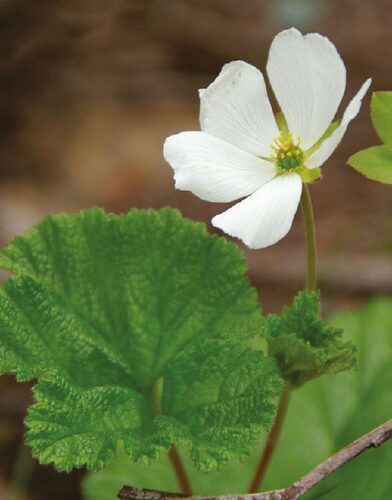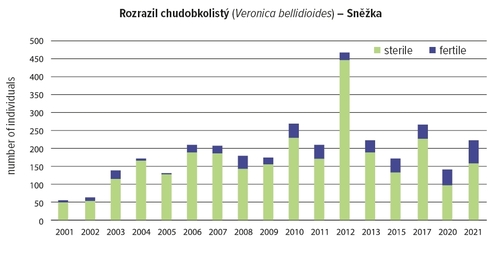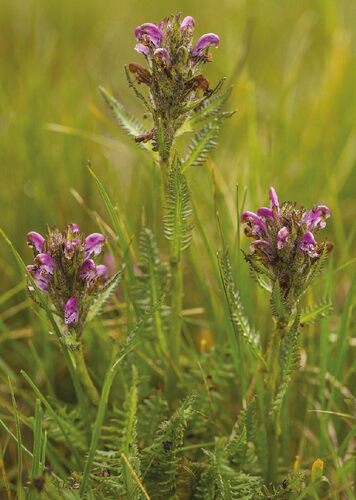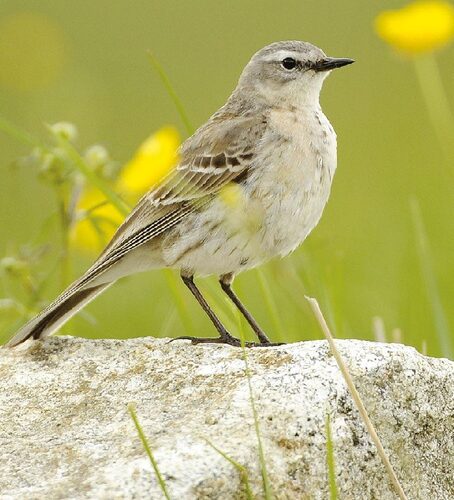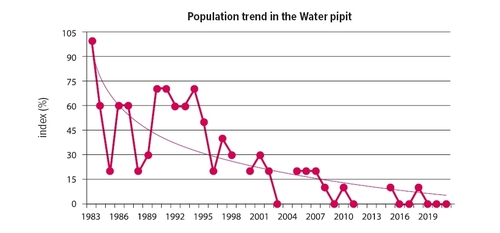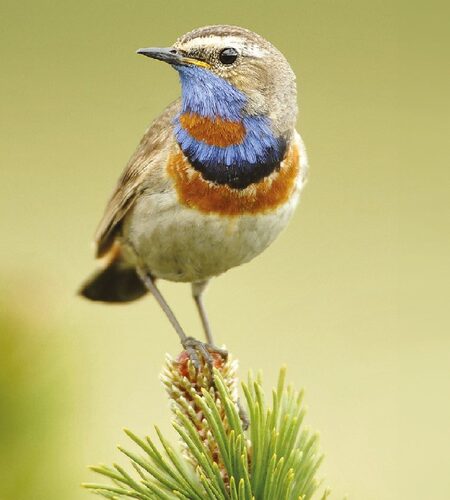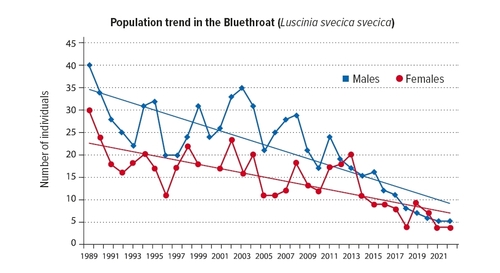Nature Conservation 2024 — 30. 5. 2024 — On Nature in the Czech Republic — Print article in pdf
Krkonoše/Giant Mountains Alpine Treeless Areas, Czech Crown Jewels


The Alpine treeless Krkonoše/Giant Mountains., mountain tundra with elements of Arctic tundra, Krkonoše/Giant Mts. tundra, and Krkonoše/Giant Mts. Arcto-alpine tundra are probably the most common designations for the 47 km² of unique ecosystem of international importance with a number of unique features; for example, geomorphological forms of glacial and periglacial origin, azonal habitats of glacial karsts, mountain ridge mires of a subarctic character, springs, dwarf mountain pine or subalpine and alpine grasslands, and with the presence of endemic species and many dozen glacial relics. The Krkonoše/Giant Mts. tundra is one of the most important subjects of protection of the Krkonoše/Giant Mts. National Park, which celebrates its 60th anniversary in 2023. What is its value from the point of view of natural sciences and how is it currently changing?
A brief history of the Krkonoše/Giant Mts. tundra and the drivers that shaped it and maintain it to the present day
The highest part of the Krkonoše/Giant Mountains differs from the alpine-type mountain range primarily in its relatively flat relief – the original peneplain was tectonically broken up during the Cenozoic and locally raised to its present positions, resulting in the formation of the Krkonoše/Giant Mts. horst structure. Levelled surfaces at higher altitudes (over about 1,350 m above sea level) occupy vast areas in the western (10 km²) and eastern (17 km²) Krkonoše/Giant Mts. and form azonal islands with a cooler climate. Unmistakably, this ancient relief was formed by glaciation and periglacial development during Quaternary glacial cycles, when permafrost, an active (i.e. repeatedly thawing) layer, and also isolated glaciers in valley heads were present. The glacial karsts, cryoplanation terraces, and extensive structural soils created at that time are the basic structural elements of the highest parts of the Krkonoše/Giant Mts. to this day (Křížek et al. 2019).
|
Krkonoše/Giant Mts. endemic species - Whitebean © Jitka Zahradníková |
| Whitebeam (Sorbus sudetica) One of the most important endemic plants of the Krkonoše/Giant Mts. Mountains, an apomictic species that arose in the Krkonoše/Giant Mts. Mountains during the Postglacial by the hybridization of the Common whitebeam (Sorbus aria) and the False medlar (Sorbus chamaemespilus), species that have recently disappeared from the mountain range. It grows in subalpine and supramontane areas in the Labský důl/Elbe River Valley and Obří důl/Giant Valley on steep (especially avalanche) slopes and their edges. The current state of natural population is about 90 bushes in the entire Krkonoše/Giant Mts. (revision in 2017–2019), which represents a decrease of more than 30% compared to the 1980s. At a number of microsites, the health of these shrubs is not satisfactory. The causes of the population decline are complex; at some microsites, the shrubs are particularly threatened by overshading and the overgrowth of surrounding woody plant vegetation; other sites of occurrence are exposed to spontaneous landslides and rockfalls, or browsing by big game. The decrease in abundance is also directly related to the low success rate of natural seedlings. In the 1980s and the second half of the 1990s, restoration plantings were carried out at several selected sites on the edge of Labský důl/Elbe River Valley and in the village of Rudník. Current management is based on cultivation of the species; in the future there will probably be steps to continue planting at historic sites. The species is relatively easy to cultivate; propagation is possible from seeds or by grafting on the rootstock of the Rowan (Sorbus aucuparia), sometimes called also the Mountain-ash. |
|
Glacial relic Cloudberry © Krkonoše/Giant Mts. National Park Administration archive |
|
Cloudberry (Rubus chamaemorus)
|
|
Map of the cloudberry distribution in the Krkonoše/Giant Mts. with the population size. |
The primary treeless area in the top parts of the Krkonoše/Giant Mts. is classified in the coldest climate region (CH4, Quitt 1971), which is characterized by a very short, cold and wet summer, long transition periods, and a very long, cold and wet winter accompanied by a long duration of snow cover. Average annual temperatures are around 2 °C on the plateaus and drop to 0 °C on the top of Mt. Sněžka. Annual total precipitation in the highest parts of the mountains is around 1,200–1,400 mm; the duration of the snow cover reaches 160–180 days (Flousek et al. 2007).
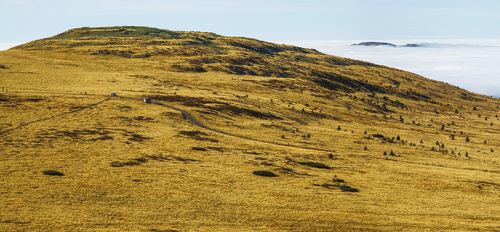
Levelled summit surface of the Eastern Krkonoše/Giant Mts. with the anemo-orographic system of the Bílé Labe/White Elbe River (waterward valley) and the summit plateau of the Úpské rašeliniště /Úpa River Mire, which falls into the leeward space of Obří důl/Giant Hole Valley. Cryoplanation terraces are clearly visible on Luční hora/Meadow Mount on the right. © Krkonoše/Giant Mts. National Park Administration archive
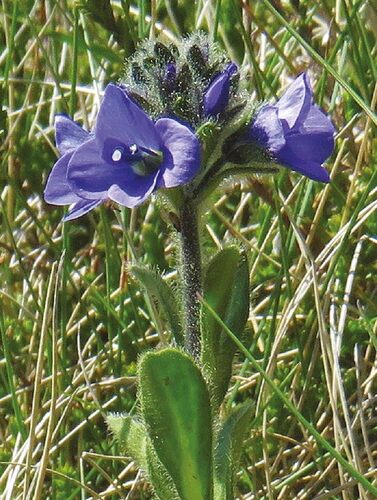
Alpine species of Daisy-leaved speedwell © Jitka Zahradníková
The persistently cold and humid climate is one of the basic conditions for the survival of unique flora and fauna (see boxes), which were often part of the tundra and forest-tundra covering Central Europe during the last Ice Age, and which have been preserved in the form of glacial relics in isolated “islands” of the European mountains and in a continuous area in the north of Europe (species with a boreomontane, boreo-alpine, or even arcto-alpine type of distribution; see Vaněk et al. 2013 for more details). Several species even have their southernmost point of distribution in the Krkonoše/Giant Mts. Together with the Jeseníky Mountains and Králický Sněžník Mountains, the alpine treeless Krkonoše/Giant Mts. is the centre of occurrence of several critically endangered (wind-swept alpine grasslands, closed alpine grasslands, snow beds) and threatened (alpine heathlands, subalpine tall grasslands) habitats (Chytrý et al. 2020). Part of the Krkonoše/Giant Mts. tundra are the mountain ridge mires (Úpské rašekiniště/Úpa River Mire and Pančavské rašeliniště/Pančava Mire, Hraniční louka/Border Meadow), which are a unique ecosystem within Central Europe. All of them are included in the list of the Ramsar Convention’s Wetlands of International Importance; together with the Polish mires, they form a transboundary/bilateral Ramsar site.
Key processes that maintain primary alpine treeless areas, such as avalanches and mudslides, are tied to glacially formed karst cliffs. Cryoplanation terraces host lichen tundra in the highest locations, for example on the top of Mt. Luční hora. The influence of relief on snow deposition, including long-lying snowfields, is also decisive for vegetation. Anemo-orographic systems (Jeník 1961) are therefore a fundamental phenomenon there, which explain the influence of relief (windward valleys, summit plateaus, leeward areas) and climate (predominant westerly wind flow) on the movement of snow and biological material by wind. The phenomenon had already played an important role in the ice ages (the formation of karst glaciers in east-facing leeward valleys, the formation of structural soils in the wind-swept top parts) and it has been playing an equally important role even today, primarily as an important disturbing factor in maintaining primary treeless areas.
Ecosystems above the tree line have been exposed to a number of anthropogenic influences that change and often worsen their condition. The soil has been widely enriched with nitrogen from atmospheric deposition (e.g. Hůnová & Paličková 2017) and acidified due to acid precipitation (Hruška et al. 2006). Another global influence is the warming of the climate, due to which, for example, the average annual temperatures in the Krkonoše/Giant Mts. have increased by 1.4 °C since the 1960s (Kliegrová et al. 2009). Locally, however, on a large area from a nature conservation point of view, trampling is manifested and soil eutrophication occurs due to the leaching of basic ions from the local roads (Müllerová et al. 2011). Diasporas of synanthropic plant species spread along roads. The extent and nature of impacts caused by the Red deer (Cervus elaphus) and the effect of its increased density in the alpine treeless areas during the growing season on the development of the individual plant species populations have been still unclear. The list should also include activities that took place in the area in recent history, in particular the large-scale planting of the Dwarf mountain pine (Pinus mugo) Lokvenc 2001) or the previous agricultural use of Nardus grasslands and grass gardens in the wider vicinity of the buildings and apparently also in relatively remote places, which ended during World War II (Lokvenc 1978, Lokvenc 2003).
Concept of the Krkonoše/Giant Mts. arctic-alpine tundra
A significant achievement that underlined the importance and uniqueness of the Krkonoše/Giant Mts. tundra, at least on a European scale, was a comprehensive publication of an eighteen-member author team in the Opera Corcontica journal (http://opera.krnap.cz) which, in 1995, precisely defined and described the phenomenon called the Krkonoše/Giant Mts. arctic-alpine tundra (Soukupová et al. 1995). Its editors were botanists Lenka Soukupová and Milena Kociánová, geobotanist and ecologist Jan Jeník, and geomorphologist Josef Sekyra. The authors came to the conclusion that the highest elevations of the Krkonoše/Giant Mts. are formed by an extraordinary landscape that shows a balanced affinity to both the tundra areas of the Scandinavian subarctic regions and the high-altitude areas of much higher and more extensive mountain ranges, and laid the foundation for its even stricter protection and remedying some inappropriate interventions (see below).
The current state of tundra vegetation and changes in recent decades
Analysis of Norway spruce (Picea abies) growth increments indicates that the upper timberline has shifted relatively significantly upwards since the last century, which means a reduction in the area of the tundra island lying above it (Treml et al. 2020). The reason is partly the climate warming and partly the overgrowth of previously treeless areas maintained by more or less intensive farming. According to Treml and his colleagues, the upper timberline is currently relatively stable, apparently because the spruce seedlings do not find much space to grow in the closed grasslands and dwarf mountain pine growths. But time-lapse photos also illustrate the growth increments of Norway spruces that have been already established there. In the near future, these may become a source of generative spread of spruce at the expense of valuable grass-herb tundra communities.
|
Daisy-leaved speedwell (Veronica bellidioides)
|
|
Development of the abundance in the Daisy speedwell (Veronica bellidioides) |
|
Endemic True Sudeten lousewort |
|
True Sudeten lousewort (Pedicularis sudetica subsp. sudetica)
The semi-parasitic herb is endemic to the Krkonoše/Giant Mts. and one of several glacial relics of the Krkonoše/Giant Mts. tundra. At present, it is sporadically found above the timberline at sites with sufficient water. Among its typical sites of occurrence are the marginal parts of mires, the surroundings of subalpine springs, rivulets, and small streams in alpine meadows and tall grasslands. We currently know of 15 spatially isolated sites, of which only two are in the western Krkonoše/Giant Mts. Mountains. However, the historical distribution of the true Sudeten lousewort was much more extensive. Based on data from herbariums and literary records, it originally occurred in many dozen sites in the western and eastern Krkonoše/Giant Mts. According to the data, the lousewort also occurred in lower locations below the timberline. Possibly, a variety of drivers are behind the significant retreat from many sites. The lousewort is a species sensitive to changes in environmental chemical patterns and also reacts sensitively to hydrological changes in its surroundings. Global changes in the environment due to air pollution load, or even local changes, can be the cause as well. In many places in the Krkonoše/Giant Mts., several sites were damaged due to ill-advised high-altitude afforestation, the use of chemically unsuitable material for the hiking trail construction, and, for example, the site at Brádlerovy Boudy/Brádler Chalet was destroyed by liming the meadow.
At present, based on the results of long-term monitoring, it appears that the real threat to the species is climate change, which leads to the acceleration of succession processes, especially the spread of taller species or increasing amounts of old grass. Slight mechanical disturbance (e.g. natural slope movements or disturbance of vegetation due to snow) is key to the survival of the True Sudeten lousewort; it opens the closed grassland and allows the species to establish itself at suitable microsites. In order to preserve it, it will probably be necessary to proceed with small-scale active interventions over time, for example removing old grass and surrounding vegetation or restoring the sites’ water regime. |
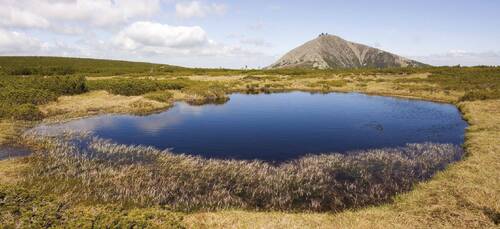
The highest peak in the Czech Republic, Mt. Sněžka (1,602 m a.s.l.) as seen from Úpské rašeliniště/Úpa River Mire © Zdeněk Patzelt

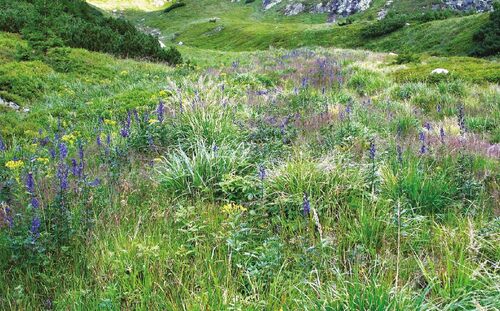
The current state of the subalpine tall herbaceous vegetation in Malá kotelní jáma/Little Kettle Cirque Hole largely overgrown with bilberry, and a representative example of a similar habitat from Úpská jáma/Úpa River Hole © Stanislav Březina and Martin Kočí
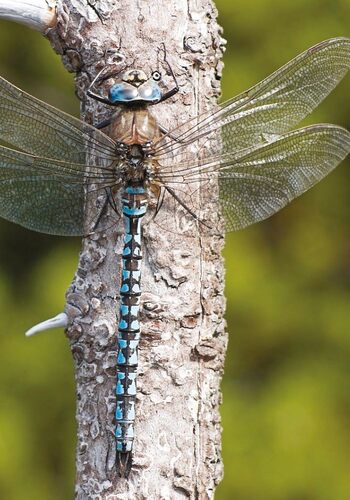
Glacial relic azure hawker © Martin Waldhauser
The
|
Water pipit at Luční bouda/Meadow Chalet © Zdeněk Patzelt |
|
Water pipit (Anthus spinoletta) The Krkonoše/Giant Mts. form the northernmost border of the European distribution range of the Water pipit – a highly endangered species bound to the top parts of the mountains, especially the rocky slopes of glacial cirques, scree fields, and subalpine and alpine meadows with scattered dwarf mountain pine. Similarly to thousands of tourists, key sites for the species are in particular the top of Mt. Sněžka and the surroundings of Úpská jáma/Úpa River Hole and Sněžná jáma(Snow Hole. In contrast to the growing number of visitors, the number of the Water pipit has been decreasing for a long time. After the first atlas mapping of the breeding distribution of Krkonoše/Giant Mts. birds in 1991–1994, the size of the Krkonoše/Giant Mts. population, including the Polish side, was estimated at 125–160 pairs (Flousek & Gramsz 1999). After twenty years (the second Krkonoše/Giant Mts. Atlas mapping), the number decreased by 30% to 40–45 pairs, with 26–29 pairs on the Czech side (Flousek et al. 2015). The dramatic decline in water pipit numbers has also been monitored by Jiří Flousek's almost 40-year bird transect census, with the first estimates numbering over 100 pairs (in 1983) decreasing to zero in the last three years (2019–2021). Current research by Tereza Petrusková from the Faculty of Natural Sciences at Charles University Prague, dealing with individual acoustic monitoring of water pipits, has brought more encouraging results. In 2019–2022, she recorded around fifteen males every year. The cause of the species’ widespread decline has not been fully understood yet, but it is mainly attributed to the warming of the climate. Not only in the Krkonoše/Giant Mts., but also in other European mountains, the shift of cryophilous water pipits to higher altitudes has been recorded (Keller et al. 2020). In the Krkonoše/Giant Mts., we know about their occurrence from 800 m above sea level (Jirsík 1955) and from 950–1,605 m above sea level (Klíma & Urbánek 1958). Today, we usually do not encounter them below 1,270 m above sea level (Flousek et al. l.c.). The most important nesting site of water pipits in the Czech Republic is limited by the summit of Mt. Sněžka at 1,602 m above sea level, and it remains a matter of time how long the changing conditions in our mountains will suit them. |
|
Population trend in the Water pipit based on the results of Jiří Flousek's spot and transect census. |
T
|
Bluethroat (Luscinia svecica svecica) © Zdeněk Patzelt |
|
Bluethroat (Luscinia svecica svecica)
Current changes in natural conditions in the summit parts of the Krkonoše/Giant Mts. contribute to the decline in another one of the main representatives of the Krkonoše/Giant Mts. tundra and the subject of protection within the Krkonoše/Giant Mts. National Park, the Bluethroat (Luscinia svecica svecica), nesting in the Krkonoše/Giant Mts. mires and wet subalpine meadows at an altitude of 1,300–1,470 m above sea level (Flousek et al. 2015). After the first confirmed nesting in 1978 in Pančavská louka/Pančava Meadow, the population of the newly discovered species had prospered and had enjoyed a gradual increase until 1989, when it reached its maximum of at least 40 males and 21 females (Miles & Formánek 1989). In 1991–1994, the population estimate was still 25–30 pairs (Flousek & Gramsz 1999); after the second atlas mapping of Krkonoše/Giant Mts. birds in 2012–2014, the estimate has already dropped to 16–19 pairs (Flousek et al. l.c.). The long-term downward trend is monitored by Bohumír Chutný and Václav Pavel during the annual mapping of the occurrence of individual singing males at all nesting sites. In the last two years, the number of males and females has been in the ratio of 5:4, with the main focus of occurrence on Úpské rašeliniště/Úpa River Mire and Stříbrná bystřina/Silver Mountain Stream. Extreme droughts cause the mud to dry up and a subsequent lack of food (i.e. insects); heavy rains increase the mortality in hatchlings. In addition to climate change and weather fluctuations, the Krkonoše/Giant Mts. population is threatened by its isolation from the core Scandinavian population, whose numbers are also decreasing and there is probably no immigration of adults from these populations at all. An imbalance in the sex ratio is also a danger. The future of the population depends on the influx of birds settling there during the spring migration north. We can influence only partially if the Krkonoše/Giant Mts. mires, which are regularly drying out and offer less and less food supply, continue to be attractive nesting sites for these birds; for example, by stabilizing the water regime, which was negatively affected by human activity in the highest altitudes in the past. Predation by domestic cats can also be a significant risk for both species, which can be reduced by a wider education of the chalet operators on the Czech and Polish sides. |
|
Development of the abundance in the Bluethroat (Luscinia svecica svecica) based on the long-term monitoring conducted by Bohumír Chutný and Václav Pavel |
The area of these valuable communities has already been shrinking rapidly. This is primarily due to the spread of dwarf mountain pine. Although it is an integral part of the local treeless areas, it does not leave much space for other tundra plant species. According to a recently published analysis of a historical orthophoto series, in the 1930s dwarf mountain pine covered about a third of the alpine and subalpine grassland area in the tundra’s eastern part, while now it occupies more than half (Potůčková et al. 2021). The increase is most pronounced in places where our predecessors, fearing floods, planted dwarf mountain pine themselves (27% of stands, Lokvenc 2001); there, dwarf mountain pine spreads by 1.8 ha a year, i.e. 0.8% of the planted area of 217 ha. However, even the naturally occurring dwarf mountain pine stands (73%) are increasing significantly, namely by an average of 2.6 ha, i.e. 0.4% of the area of natural stands per year. Dwarf mountain pine expands even in extreme habitats – on the highest Krkonoše/Giant Mts. peaks, the authors recorded a horizontal increase in the dwarf mountain pine by dozens of centimetres in 8 years.
The tundra habitats have been also shrinking as a result of being overgrown with tall herbaceous synanthropic vegetation. In the western Krkonoše/Giant Mts. part of the tundra there are about 30 km of roads, of which roughly 45% were paved with alkaline debris (Vítková et al. 2012). Limestone and magnesium are leached from road structures and change the oligotrophic soil conditions to which the tundra vegetation of short tundra grasses is adapted. The average width of synanthropic road verges reaches dozens of metres (Vítková et al. l.c.) and has been constantly growing. The verges are widest in sloping conditions, on asphalt roads, and on roads paved with dolomite. The average growth rate of synanthropic vegetation in the entire studied area was estimated at 0.6 ha per year in 1997 (Müllerová et al. 2011).
Similar significant changes – the replacement of one type of vegetation with another – occur in the tundra even without direct human intervention. If we step onto the wind-swept edges of the Krkonoše/Giant Mts. ridges, we will see around us a greater amount of heathland vegetation and less open alpine meadows (the classic lichen tundra) than our predecessors (Fabšičová et al. in prep.). This is the result of so-called “shrubification”, one of the fundamental processes that has recently changed the face not only of the Krkonoše/Giant Mts. tundra but also of tundra habitats around the world. To some extent, the Common heather (Calluna vulgaris), Bilberry (Vaccinium myrtillus), and other shrubs were present in the original communities. Therefore, from a nature conservation point of view, we cannot equate their expansion with, for example, the expansion of synanthropic road verges. On the other hand, it is precisely the growth of these shrubs that, together with the spreading of dwarf mountain pine, limits the space for the Alpine hawkweed (Hieracium alpinum), Rock bent (Agrostis rupestris), tufted fescue (Festuca supina), and other tiny plant species, specialized to grow in extreme weather conditions; among the disappearing species, there are many more endangered plant species than among the species that are increasing in the tundra.
Additional analyses of the Brno branch of the Institute of Botany, the Czech Academy of Sciences further show that the current species composition there is more thermophilic than the communities from historical records. However, it would be simplistic to attribute the ongoing changes solely to the warming of the climate. A deeper analysis shows that although specialized, cold-adapted plant species are indeed disappearing from the tundra, their niche is not being filled by new thermophilic colonizers from lower altitudes, but mostly by generalists indifferent to temperatures. Typical examples are, not surprisingly, the bilberry and heather, which are able to dominate the wind-swept ridges of the Krkonoše/Giant Mts. as well as nutrient-poor habitats a thousand metres below. It is therefore probable that climate change is only one of the triggers for the described expansion, while other drivers may be the abandonment of farming in the tundra after World War II or changes in the soil chemical properties as a result of atmospheric nitrogen deposition and acid rain (Schwarz et al. 2007, Hůnová & Paličková l.c.).
For another example of changes in the vegetation patterns, let us descend from the wind-swept edges to the steep cirque slopes. Botanists are immediately attracted by the subalpine grasslands with the Reed grass (Calamagrostis arundinacea), which grow on stable scree cones in the lower parts of the avalanche pathways. Due to their species diversity and the abundant presence of endangered plant species, in some places they are called, together with the surrounding shrub-herb vegetation, the Krkonoše/Giant Mts. gardens. Unfortunately, most of the historical areas were repeatedly not found, so in their place we can now find relatively drab vegetation of subalpine grasslands with the Hairy small-reed (Calamagrostis villosa). The Long-leaved hare’s ear (Bupleurum longifolium), Narcissus anemone (Anemonastrum narcissiflorum), and the Giant cat’s ear (Hypochaeris uniflora) are examples of typical species that are disappearing from there together with their habitat. When we were looking for a variety of vegetation in the lower parts of the Malá kotelní jáma/Little Kettle Cirque Hole, which, according to historical records, was still abundant there in the 1990s, we mostly came only across fragments in the “sea” of bilberry.
What are the causes of the described changes in the Krkonoše/Giant Mts. gardens? They are located on avalanche pathways, so it is not difficult to imagine that the changes may be related in some way to changes in the avalanche dynamics. A summary analysis of the long-term Krkonoše/Giant Mts. avalanche register shows that large base avalanches have been decreasing in recent decades (Součková et al. 2022). With them, disturbances can decrease which are able to create successively early habitats occupied by the community with Calamagrostis arundinacea. If this were the case, it would be a relatively logical consequence of ongoing climate change. However, this interpretation has not yet been confirmed by any comprehensive research. As in the Krkonoše/Giant Mts. plateaus, the above-mentioned factors, including the cessation of farming, can contribute to the changes as well (extensive grazing used to take place in the cirque, and its ending may have contributed to the aforementioned changes; Lokvenc 2003).
And thirdly, let us look at the changes at the Krkonoše/Giant Mts. Ramsar raised peat-bogs. Fortunately, as a whole, they do not show major signs of vegetation changes; however, the question is what the more frequent repetition of dry years will do to their vegetation. Analysis of the upland vegetation dynamics has shown that, over the last decade, there has been an increase in carpets of the Flat-topped bog moss (Sphagnum fallax) with the Hare's-tail cottongrass (Eriophorum vaginatum), i.e. the vegetation of continental to subcontinental raised peat-bogs, which in addition to the Krkonoše/Giant Mts. also grow at lower altitudes; in contrast, there has been a decrease in boreal raised bogs with the Deer grass (Trichophorum cespitosum), which cannot be found anywhere else in the Czech Republic except the Krkonoše/Giant Mts.. It is these raised peat-bogs, together with several other habitats, which demonstrate the often-repeated preference of the Krkonoše/Giant Mts. tundra to arctic and boreal environments. To clarify, let us mention that among the plant species having been declining most significantly from the local raised peat-bogs, we can find two types of vascular plants with an affinity to the north: the Cloudberry (Rubus chamaemorus), which has one of its most southerly sites of occurrence just there, and the endemic True Sudeten lousewort (Pedicularis sudetica subsp. sudetica), which is part of the complex taxa with a boreal distribution.
Now we will end the rather sad list of changes in the tundra vegetation. It is obvious that the Krkonoše/Giant Mts. tundra is changing; endangered habitats are gradually disappearing and plant species adapted to life in harsh climatic conditions are decreasing. Species with a Nordic type of distribution, which are among the prominent subjects of protection in the Krkonoše/Giant Mts. National Park because they make the Krkonoše/Giant Mts. tundra internationally unique are disappearing. This trend most probably also occurs in other organisms (fungi, invertebrates), but there is little comparable data to confirm it.
A number of findings on the tundra vegetation development over the last decade were obtained within many projects, which were initiated by the Krkonoše/Giant Mts. National Park Administration. At present, this is mainly the project Vegetation of the Krkonoše/Giant Mts. tundra – past, present and future financed by the EU funds through the Operational Programme Environment (OPE) and managed by the Administration: it has been running since 2018. Its aim is to map the current state of the tundra vegetation and its changes, to categorize the conservation value of the stands, and the degree of their threat. Subsequently, on the basis of this information, develop a sustainable method of monitoring tundra vegetation, with the coordinated use of standard field and remote sensing methods. The obtained data should also be used for a strategic analysis of the Krkonoše/Giant Mts. tundra management in the coming period. ■
The list of references is attached to the online version of the article at www.casopis.ochranaprirody.cz
- - - -
Cover photo:
Levelled summit surface of the eastern (in the foreground with Mt. Studniční hora/ Water Well and Luční bouda/Meadow Chalet) and western (in the background with Mt. Kotel/Cirque and Mt. Vysoké kolo/High Circle) Krkonoše/Giant Mts. This environment consists of islands above the timberline with all the features of arcto-alpine tundra. In the foreground is the Úpská jáma/Úpa River Hole, glacial cirque with significant avalanche pathways lowering the timberline. © Krkonoše/Giant Mts. National Park Administration archive



